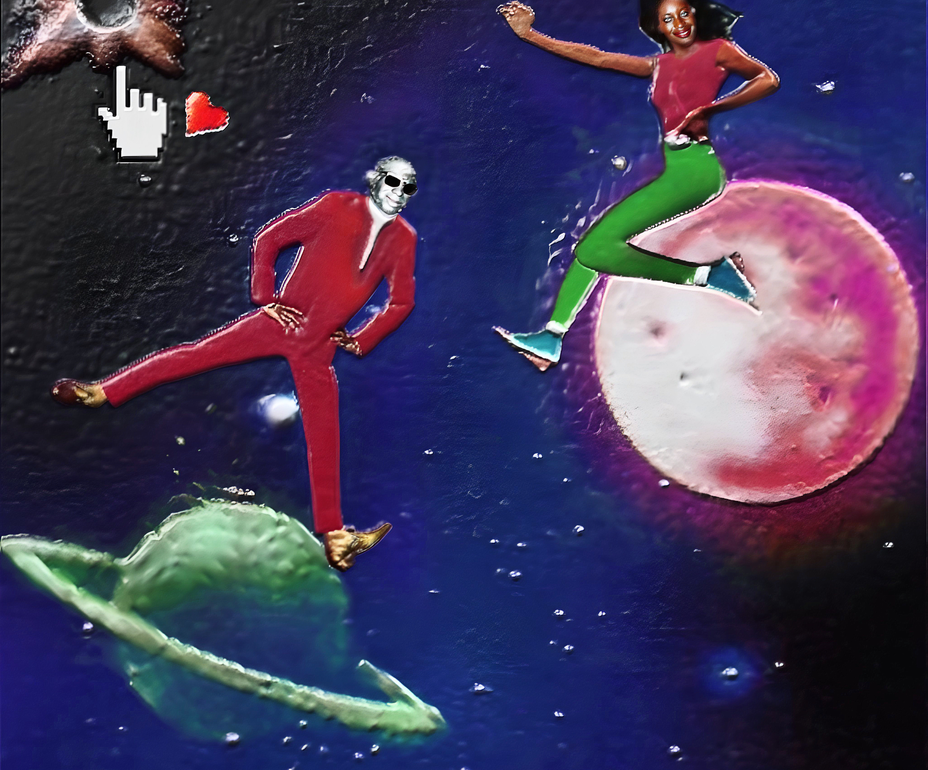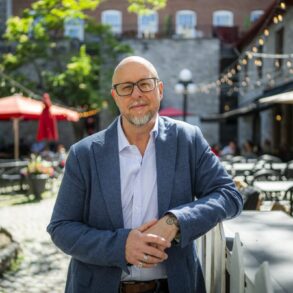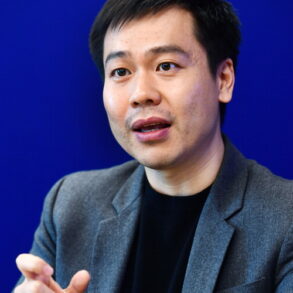A few years ago, Stephanie Williams and her husband fielded a question from their son: How had they met?
So they told him. They’d first encountered each other on a website called BlackPlanet.
To the 5-year-old, the answer seemed fantastical. “He clearly didn’t hear ‘website,’ ” Williams, a writer and comic creator, told me. “He was like, ‘Wait, you all met on Black Planet? Like, there’s a planet that’s full of Black people? Why did you leave?!’ ”
Williams had to explain that they’d actually been right here on “regular Earth.” But in some ways, their son’s wide-eyed response wasn’t so off base: From the perspective of the 2020s, there is something otherworldly about the mid-aughts internet that brought his parents together. In a social-media era dominated by the provocation and vitriol of billionaire-owned mega-platforms, it can be hard to imagine a time when the concept of using the internet to connect with people felt novel, full of possibility—and when a site billed as the homepage of the Black internet had millions of active users.
BlackPlanet went live in 1999, nearly three years before Friendster, four years before MySpace, five years before Facebook, and seven years before Twitter. In those early years, the internet was still seen by many as a giant library—a place where you went to find things out. Sure, the web had chat rooms, bulletin boards, and listservs. But BlackPlanet expanded what it meant to commune—and express oneself—online.
The site offered its users the opportunity to create profiles, join large group conversations about topics such as politics and pop culture, apply to jobs, send instant messages, and, yes, even date. It provided a space for them to hone their voice and find their people. A visit to someone’s customizable BlackPlanet page would probably tell you where they grew up, which musicians they idolized, and what they looked like. “That now seems like the most obvious thing in the world,” Omar Wasow, one of the site’s co-founders, told me, “but at the time reflected a real break from the dominant ideas about how this technology was meant to be used.”
BlackPlanet is often overlooked in mainstream coverage of social-media history. But at its peak, it wasn’t just some niche forum. Despite skepticism within the tech industry that a social-networking site geared toward African Americans could be successful, about 1 million users joined BlackPlanet within a year of its launch. By 2008, it had about 15 million members. The site’s cultural reach extended beyond what numbers can capture: BlackPlanet amplified the work of emerging artists, served as a powerful voter-outreach hub for Barack Obama’s first presidential campaign, and fostered now-prominent voices in contemporary media. Gene Demby, a co-host of NPR’s Code Switch podcast, told me he joined BlackPlanet while attending a predominantly white college as a way to make connections beyond his campus. “It was sort of like, ‘Give me all the Black people I can find!’ ”
The site and its users helped establish visual-grammar and technical frameworks—such as streaming songs on personal pages and live, one-on-one chatting—that were later widely imitated. BlackPlanet arguably laid the foundation for social media as we know it, including, of course, Black Twitter.
Now, nearly 25 years after its launch, looking back at BlackPlanet’s glory days can be more than just an exercise in nostalgia. Today’s social-media platforms often seem designed to reward the worst in humanity, subjecting their users to rampant hate speech and misinformation. Perhaps by revisiting BlackPlanet and the story of its rise, we can start to envision a different future for the social web—this time, one with the potential to be kinder, less dangerous, and more fun than what the past two decades have given us.
Omar Wasow met Benjamin Sun in the late 1990s, when they were among the few people of color working in New York City’s tech scene. After graduating from Stanford University in 1992, Wasow had moved back to his hometown and started a hyperlocal community hub and internet-service provider, New York Online, which he operated out of his Brooklyn apartment. The service had only about 1,000 users; Wasow made his actual living by building websites for magazines. So he was excited when he met Sun, then the president and CEO of the social-networking firm Community Connect, which in 1997 launched an online forum for Asian Americans called AsianAvenue.
Wasow, the son of a Jewish economist and a Black American educator, had been thinking about how to build community on the internet for years. Like many early tech enthusiasts, he frequented the bulletin-board systems (BBSes) that proliferated in the late ’80s and early ’90s. Spending time on those primarily text-based, hobbyist-run dial-up services helped him anticipate how popular social technologies could be. Many of the BBSes were standard tech-nerd fare—chats where users would discuss pirating software or gossip about buzzy new product releases. But two sites in particular, ECHO (East Coast Hang Out) and the WELL (Whole Earth ’Lectronic Link), modeled a more salonlike online experience that piqued Wasow’s interest. He realized that people didn’t necessarily want the internet to be just an information superhighway. They wanted connection; they wanted to socialize.
Wasow admired the cultural cachet that AsianAvenue had already amassed—enough, by 1999, to compel Skyy Spirits to discontinue a print ad for vodka that featured a racist image of an Asian woman after the site’s users protested. Sun, for his part, wanted to expand Community Connect to new forums for other people of color. They decided to work together to build a new site that would allow users to participate in forum-style group discussions, create personal profile pages, and communicate one-on-one.
But Wasow, Sun, and the rest of the Community Connect team faced a major challenge in launching BlackPlanet: the perception that Black people simply didn’t use the internet. It was true, around the turn of the millennium, that white households were significantly more likely to have internet access than Black ones. At the same time, reports of this “digital divide” had helped foster a myth of what the media historian Anna Everett has termed “Black technophobia.” Well into the aughts, much of the coverage of Black American tech usage had a tone of incredulity or outright condescension. As a result, advertisers and investors were hesitant to back Wasow and Sun’s site. Would it really attract enough users to be viable?
Wasow felt confident that it would. The very first week it went live, in September 1999, a friend teased Wasow about the ticker on BlackPlanet’s homepage, which showed how many people were logged on at any given moment: “I logged in, and it said there were, like, 15 people online,” Wasow remembered him saying. “You sure you want to leave that up? Because it sort of feels like an empty dance floor.” By the next week, the ticker showed closer to 150 people. Every day, the number climbed higher.
Within a few months, BlackPlanet had so many users that they couldn’t possibly have squeezed onto any dance floor in New York City. Wasow began to spend much of his time speaking at marketing conferences and advertising events. Still, he and Sun struggled to attract significant capital. “Even as the site was showing real evidence of just incredible numbers, people had this story that was like, in some ways, ‘That couldn’t be!’ ” Wasow recalled. “Because the digital divide was the narrative in their heads … It wasn’t enough just to show success. We had to be insanely successful.”
By May 2001, less than two years into its run, BlackPlanet had more than 2.5 million registered users. Wasow himself had taught Oprah Winfrey and Gayle King how to surf the Net on national television (after learning how to use a mouse, the women responded on air to emails from Diane Sawyer, Hillary Clinton, and Bill Gates). BlackPlanet had secured advertising deals with the likes of Hewlett-Packard, Time magazine, and Microsoft. In the last quarter of 2002, BlackPlanet recorded its first profit. (Facebook, by contrast, did not turn a profit until 2009, five years after its launch, and Twitter didn’t until 2017, 11 years after its founding.) By then, it was the most popular Black-oriented website in America.
Wasow never forgot one seemingly trivial detail from BlackPlanet’s fledgling days. When the site went live, “the first person who logged in was ‘TastyTanya,’ ” he said, laughing. “For whatever reason, it’s now more than 20 years later and I still remember that screen name.”
I tracked down the woman once known as TastyTanya, who was 20 when she joined the site. Today, she’s a married mother of two young children who works in accounting; she prefers not to have her real name attached to her old handle. When we spoke, she recounted how strangers on the site would strike up conversations with her because someone called TastyTanya just seemed approachable. One man she met on the site even emblazoned her BlackPlanet profile picture onto a CD he burned for her and sent her in the mail, which didn’t seem creepy at the time. As quaint as that might sound now, TastyTanya’s experience perfectly illustrates what made BlackPlanet so fun. In its heyday, the site was largely populated by users just like her, people in their teens and 20s who were doing online what people in their teens and 20s have always done: figuring out who they want to be, expressing their feelings, and, of course, flirting.
Like many early users, Shanita Hubbard came to BlackPlanet in the early 2000s as a college student, eager to take advantage of the dial-up internet in her dorm room. A member of the Zeta Phi Beta sorority at a historically Black college in South Carolina, Hubbard had heard about a cool-sounding site that would help her meet Zetas on other campuses. She chose the screen name NaturalBeauty79 and peppered her profile with references to her sorority, natural hair, and the music she loved. BlackPlanet soon became a fixture of her undergraduate experience.
Hubbard is now a freelance journalist and the author of Ride or Die: A Feminist Manifesto for the Well-Being of Black Women. When I asked her how she’d describe those days on BlackPlanet to a hypothetical Gen Zer, she laughed: “I feel like I’m trying to explain a rotary phone.”
In retrospect, she told me, it was her first experience understanding how technology could broaden her universe not just intellectually, but socially. On BlackPlanet, Hubbard befriended Black people from all walks of life, including Zetas as far away as California. “What we think Black Twitter is today is actually what BlackPlanet was eons ago in terms of connecting and building authentic community,” Hubbard said. “Except there was levels of protection within BlackPlanet that we never got on Twitter.”

Some of the insulation was a product of the site’s scale and user makeup: BlackPlanet was both smaller and more racially homogeneous than today’s major social-media networks. Its infrastructure played a role too. Users could see who else was online or recently active, send private messages, and sign one another’s digital “guest book,” but group discussions of contentious topics tended to happen within specific forums dedicated to those issues, not on a centralized feed where bad-faith actors would be likely to jockey for the public’s attention. There was no obvious equivalent to the “Retweet” button, no feature that encouraged users to chase virality over dialogue.
BlackPlanet users talked candidly about politics, debated sports, and engaged in conversations about what it meant to be Black across the diaspora. A 2008 study found that the “Heritage and Identity” forum on BlackPlanet (as well as its equivalents on AsianAvenue and another sister site, MiGente), where users started threads such as “I’m Black and I Voted for Bush,” consistently attracted the highest engagement rate. The conversation wasn’t always friendly, but it was rarely hostile in the ways that many Black social-media users now take for granted as part of our digital lives. “There was never a time … where racists found us on BlackPlanet and infiltrated our sorority parties or flooded our little BlackPlanet pages with racist nonsense,” Hubbard said. “It’s almost like the white gaze was just not even a factor for us.”
Eventually, Hubbard began using the site for more than friendly banter. “Everyone likes to pretend it was all about formulating a digital family reunion,” she said. “That’s true. But that doesn’t tell the full story.”
In 2001, when online-dating services such as eHarmony were still in their infancy, BlackPlanet launched a dating service that cost $19.99 a month and helped members screen their would-be love interests. The site offered its members something that is still rare in online romance: Everyone who signed up for BlackPlanet’s dating service wanted to be paired with other Black people.
Soon enough, BlackPlanet romances were referenced in hip-hop lyrics and on other message boards, becoming a kind of shorthand for casual dating among young people. As Hubbard put it, BlackPlanet was “Tinder before there was swiping right, honey.”
If you wanted your BlackPlanet page to look fly—and of course you did—you had to learn how to change the background colors, add music, and incorporate flashing GIFs. At the height of the site’s popularity, the competition led some users to protect their pages by disabling the right-click function that allowed others to access their HTML codes. Giving users the opportunity to digitally render themselves made the site feel less like a staid old-school forum and more like a video game. That’s how BlackPlanet sneakily taught a generation of Black internet users basic coding skills, an accomplishment that remains among Wasow’s proudest.
Every former BlackPlanet user I spoke with for this story recalled doing at least a little coding, though most didn’t know to call it that at the time. Some told me they continued building those skills and went on to work in tech or media, at companies such as Meta and Slate. For others, though, learning HTML was just a way to express personal style. “We were our own webmaster, our own designer, our own developer,” Hubbard said. “We were maintaining it and then we would switch it up every couple of weeks to keep it fresh and poppin’.”
It wasn’t just BlackPlanet users who took note of how much fun customizing one’s own webpage could be. In late 2002, a man named Tom Anderson decided that he and his business partner should start a new social network.
When MySpace launched in 2003, the site included several features that were similar to the ones BlackPlanet had offered for years. But where BlackPlanet and the other Community Connect sites emphasized the value of shared heritage and experiences, MySpace billed itself as the universal social network. “I had looked at dating sites and niche communities like BlackPlanet, AsianAvenue, and MiGente, as well as Friendster,” Anderson told Fortune in 2006 (by then, he was better known as “MySpace Tom”). “And I thought, ‘They’re thinking way too small.’ ”
MySpace didn’t immediately cut into BlackPlanet’s user base. It would take at least five years and the advent of three more major social networks before BlackPlanet saw a significant downturn in its numbers. Even as late as October 2007, when then–presidential candidate Obama joined BlackPlanet, he quickly acquired a large following.
Still, as time went on, some BlackPlanet users found themselves visiting the site less frequently. Mikki Kendall, a cultural commentator and the author of Hood Feminism: Notes From the Women That a Movement Forgot, told me she didn’t spend as much time on BlackPlanet as some of her friends did in part because she thought of it primarily as a meeting space for singles. Also, its interface didn’t appeal to her. “BlackPlanet was both ahead of its time and unfortunately not far enough ahead of its time,” she said. The site was full of delays, and the mobile option seemed all but unusable. “I always felt like it was the bootleg social-media network, even though it wasn’t,” she added. “But it was run like somebody was in the back with a hammer just knocking things together and hoping it came through.”
Some observers I spoke with attributed BlackPlanet’s decline partly to the difficulty its founders had attracting capital. Wasow remembered Community Connect bringing in a total of $22 million by 2004. In 2007, Facebook received $240 million in investment funds just from Microsoft. “What does it take financially to get Facebook to where it is? How much money?” Charlton McIlwain, a professor at NYU and the author of Black Software: The Internet & Racial Justice, From the AfroNet to Black Lives Matter, told me. How far into “the millions and into the billions of dollars has it taken for a Google to experiment and succeed at some things and fail at a lot of things, but then be a dominant player in that ecosystem?” Black American culture has always been a powerful engine of innovation, but this has too rarely translated into actual financial rewards for Black people.
In 2008, three years after Wasow left BlackPlanet to attend graduate school at Harvard, the Maryland-based urban-media network Radio One (now Urban One) purchased Community Connect for $38 million. At the time, BlackPlanet still had about 15 million users. But with Twitter slowly gaining attention outside Silicon Valley and Facebook beginning to overshadow MySpace, BlackPlanet simply didn’t have the resources to continue attracting the same mass of users that it once had. The rise of these social-media giants—and the industry-wide shift to prioritizing mobile experiences—decimated BlackPlanet’s numbers in the years after it was acquired.
Still, the site held on. In February 2019, BlackPlanet got a notable boost. That month, Solange Knowles released the visuals for When I Get Home, her fourth studio album, exclusively on the site. The project arose after Solange tweeted about wanting to release a project on BlackPlanet and caught the attention of Lula Dualeh, a political and digital strategist who had just started in a new role there.
“A lot of people were asking themselves the question What’s next outside of Facebook and Twitter and Instagram? ” Dualeh told me. Maybe the answer could be a return to BlackPlanet. In the days following the rollout of the When I Get Home visuals—a collection of art and music videos—BlackPlanet saw more traffic than it had in about a decade, as old and new visitors alike flocked to the site. Black Twitter was abuzz. “What I didn’t realize is that there was just this underbelly of nostalgia around BlackPlanet,” Dualeh said.
Despite the success of the Solange rollout, BlackPlanet hasn’t seen a significant, lasting bump in numbers. Nostalgia alone won’t be enough to keep users engaged—no matter how much worse Twitter (now X) has gotten. The BlackPlanet interface feels dated, with an early-2010s-Facebook quality to it, even as the posts crawling across the main feed reference music or events from 2024. Alfred Liggins, Urban One’s CEO, acknowledges that there’s work to be done on the technical side. But he argues that the site is still relevant. And although today’s BlackPlanet does often seem like a repository for WhatsApp memes, YouTube links, and conversation prompts copied over from other platforms, some users do continue to use it to share photos and reflections from their real life.
In the current internet landscape, talk of eliminating hostility from large, multiracial platforms feels idealistic at best—particularly when those platforms are owned by egotistical billionaires such as Elon Musk, who has used Twitter to endorse racist claims and alienate parts of its user base. Still, there’s reason to hope that we may be entering a new era of social networking that prioritizes real connection over conflict-fueled engagement. Several new microblogging platforms have launched in recent years. Spill, a Black-owned Twitter alternative co-founded by two of the app’s former employees, joins networks such as Mastodon and Bluesky in offering users a space that isn’t subject to the whims of provocateurs like Musk.
Wasow, for his part, is cautiously optimistic. The emergence of smaller, more dedicated digital spaces, he said, could “take us back to some of that thriving, ‘Let a thousand flowers bloom’ version of online community.” It’s not that he expects people to stop using the huge social networks, Wasow said, just that he can see a world where they log on to Facebook and Snapchat and Instagram less.
The emergence of these new outlets also serves as a useful reminder: The social web can take many forms, and bigger is not always better. The thrill of the early internet derived, in part, from the specificity of its meeting places and the possibility they offered of finding like-minded people even across great distances (or of learning from people whose differing perspectives might broaden your own). Not everyone is lucky enough to meet a future spouse on their web planet of choice. But the rest of us still have the capacity to be transformed for the better by the online worlds we inhabit.
This article appears in the May 2024 print edition with the headline “Before Facebook, There Was BlackPlanet.” When you buy a book using a link on this page, we receive a commission. Thank you for supporting The Atlantic.
This post was originally published on this site be sure to check out more of their content








